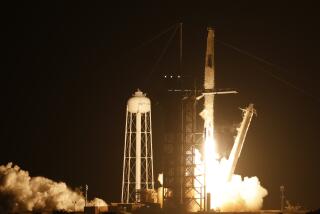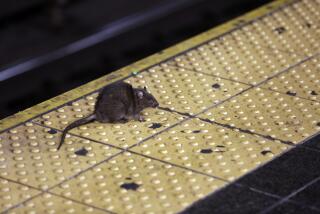7 Astronauts Fly High in Orbit, Draw Blood in Name of Science
- Share via
KENNEDY SPACE CENTER, Fla. — Columbia and its seven astronauts blasted off on a belated mission Monday, carrying 48 rats, that will be poked, prodded and in some cases decapitated by guillotine and dissected in orbit.
All in the name of science.
Five of the rats are part of UC Irvine research on the effects of weightlessness. Scientists Kenneth Baldwin and Vincent Caiozzo have designated a series of muscle mass tests for the five, hoping to learn more about why and how loss of gravity causes muscles to change in humans and animals.
The astronauts aboard Columbia quickly got started on their 14 days of space checkups, drawing blood from one another, measuring their blood pressure and noting any symptoms of motion sickness.
The mission--the longest ever planned for a space shuttle--is intended to help scientists develop measures for counteracting the debilitating effects of space travel, including changes in muscle mass. Astronauts will test the UCI rats in space, while Baldwin and Caiozzo are simultaneously testing comparison rats on the ground at UC Irvine labs.
In an interview Monday in Irvine, Baldwin said the UCI researchers believe the tests will result in knowledge useful for humans on land as well as in space.
“We think the information we learn from the tests will apply to people who go through stages of aging, as well as to people who have injuries and have a dramatic reduction in physical activities,” Baldwin said.
The two Irvine scientists are scheduled to greet Columbia when it lands at Edwards Air Force Base in Los Angeles County on Nov. 1. They will then examine firsthand their lab rats and make additional tests.
Columbia blasted from its Florida launch pad Monday morning after two previous delays.
“Guys, the third time’s a charm,” orbiter test director Brian Monborne assured the crew before liftoff.
Delayed 10 seconds by a stray Navy plane, the 2,000-ton spaceship rose from its seaside pad at 7:53 a.m. PDT and tore through three decks of clouds on its way to a 176-mile-high orbit.
Two crew members had catheters threading through their veins for launch--Martin Fettman, the first U.S. veterinarian in space, and Shannon Lucid, a biochemist who became the first woman to fly in space four times. The catheters were hooked to white backpacks with floating cables, making the two look like a pair of bees.
In addition to the UCI rats being used for tests of muscle mass, other rats on the Columbia will be tested for such things as bone loss in space.
Throughout the mission, Fettman and the others will draw blood from the 2- to 3-month-old male rodents, inject isotopes and hormones, and collect the animal droppings to measure calcium content, an indicator of bone loss.
Times staff writer Bill Billiter also contributed to this report.






